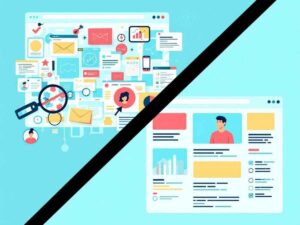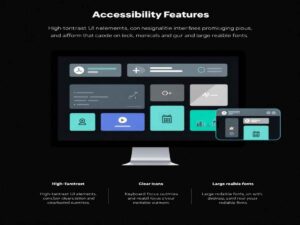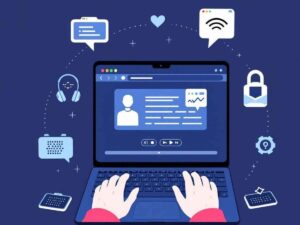Understanding the Basics of Web Accessibility and Why It Matters

Imagine landing on a website that’s impossible to use because the text is unreadable, the navigation doesn’t work, or there’s no way to understand the visuals. For millions of people with disabilities worldwide, that’s the experience they face every day. But web accessibility can change that.
Web accessibility ensures that websites are usable by everyone, including individuals with disabilities. While it is a technical concept, its implications go far beyond technology, impacting user satisfaction, legal compliance, and business growth. This blog will explore what web accessibility is, why it’s crucial, the standards to follow, and how you can create an accessible website.
What Is Web Accessibility?
Definition of Web Accessibility
At its core, web accessibility is about designing and developing websites so that all users, regardless of their physical, cognitive, or visual abilities, can access and interact with the content. It ensures equal access to information and functionality, removing barriers that might otherwise exclude some users from effectively engaging with a website.
Key Features That Define Accessibility
An accessible website incorporates specific elements to meet the needs of diverse users:
- Keyboard Navigation: Allowing users to browse without a mouse.
- Readable Fonts: Using clear, legible typography for easy reading.
- Color Contrast: Ensuring text stands out against the background for those with visual impairments.
- Screen Reader Compatibility: Supporting assistive technologies like screen readers for blind users.
- Alt Text: Providing descriptions for images so they can be interpreted by assistive devices.

Who Benefits from Accessible Websites?
Accessibility doesn’t only help users with disabilities; it improves the overall experience for everyone. Here’s how:
- Visual Impairments: For those with partial or total blindness, screen readers make content accessible.
- Hearing Impairments: Captioned videos and text alternatives ensure inclusivity.
- Motor Impairments: Keyboard navigation helps users who cannot operate a traditional mouse.
- Cognitive Disabilities: Simplified layouts and clear content assist users with attention disorders or learning disabilities.
A Real-Life Example
Imagine a visually impaired user attempting to book a flight online. Without proper alt text for buttons or accessible forms, the process becomes frustrating or even impossible. A website optimized for accessibility transforms this scenario into a seamless and positive experience.
Why Web Accessibility Matters
Legal Compliance
Web accessibility isn’t optional; it’s often a legal requirement. Laws like the ADA (Americans with Disabilities Act) and globally recognized standards like WCAG (Web Content Accessibility Guidelines) mandate accessible websites. Non-compliance can lead to lawsuits, reputational damage, and financial penalties.
Business Benefits of Accessibility
Reach a Bigger Audience:
- By making your website accessible, you tap into a larger market of users, including the 1 billion people globally who live with disabilities.
Increase Customer Loyalty:
- An inclusive design demonstrates that your brand cares, building trust and long-term customer relationships.
Improved User Experience for Everyone
Accessibility features like larger text sizes, voice navigation, or simplified interfaces enhance the usability of your website for all visitors, not just those with disabilities.
SEO Advantages
Google’s algorithms reward accessible websites. Features such as alt text, proper heading tags, and descriptive links not only improve usability but also boost search engine rankings, helping your site appear in more search results.

Key Web Accessibility Standards and Guidelines
Introduction to WCAG Guidelines
The Web Content Accessibility Guidelines (WCAG) are the gold standard for building accessible websites. They ensure websites are:
- Perceivable (information is available to all)
- Operable (navigation is smooth and intuitive)
- Understandable (content is clear and simple)
- Robust (compatible with assistive tech)
Different WCAG Compliance Levels
- Level A: Basic web accessibility features.
- Level AA: Addresses common barriers, such as low contrast.
- Level AAA (highest level): Enhances usability further but is often challenging to achieve.
Compatibility with Assistive Technology
Web accessibility ensures seamless integration with tools like:
- Screen readers (e.g., JAWS or NVDA).
- Voice recognition software.
- Braille devices.
A Quick Accessibility Checklist
- Text alternatives for non-text content.
- Mobile-friendly design.
- Proper heading structure.
- Sufficient color contrast ratio.
- Accessible form labels and error messages.

How to Make Your Website Accessible
Key Design Principles
- Improve Visual Design:
- Use high-contrast color combinations.
- Choose sans-serif, scalable fonts like Arial or Roboto.
- Simplify Content:
- Write in plain language to ensure clarity.
- Avoid technical jargon unless it’s necessary.
Utilize HTML and ARIA
- HTML Semantics:
- Use native HTML elements (e.g., <header>, <nav>, <button>).
- ARIA Roles and Attributes:
- Enable enhanced functionality for screen readers.
Enhance Navigation and Forms
- Ensure the site is fully operable using only a keyboard.
- Clearly label input fields in forms for ease of understanding.
Use Automated Accessibility Tools
Tools like WAVE, Axe, and Lighthouse can identify existing barriers on your website and provide recommendations for improvement.
Ongoing Maintenance
Accessibility isn’t a one-time effort. Regular audits and updates are essential to ensure your website remains compliant as standards evolve.

Tools and Resources for Web Accessibility
Popular Accessibility Testing Tools
- WAVE (Web Accessibility Evaluation Tool).
- Axe (Automated Accessibility Testing).
- Lighthouse (Google’s built-in auditing tool).
Plugins and Extensions
- WordPress Accessibility Plugins:
- WP Accessibility Improved.
- UserWay Accessibility Widget.
Educational Resources
- WebAIM (Accessibility in Mind): Offers comprehensive guides.
- Deque University: Provides online accessibility training.
Common Web Accessibility Mistakes to Avoid
Missing Alt Text:
- Every image should have an accurate and descriptive alt tag.
Poor Color Contrast:
- Ensure the color contrast ratio meets WCAG success criteria.
Forms Without Labels:
- Always make sure fields are properly labeled for screen readers.
Forgetting Mobile Accessibility:
- Test your website’s responsiveness and accessibility on mobile devices.

Accessibility Is an Opportunity, Not an Obstacle
Prioritizing web accessibility is not just the right thing to do; it’s a smart business decision. It creates a more inclusive internet, broadens your audience, enhances user experience, and boosts your SEO. Whether you’re a web developer, business owner, or designer, incorporating accessibility into your strategy is a win-win.
Start small with simple design fixes or accessibility tools, but take the first step today. Together, we can create an internet that everyone can enjoy.
Frequently Asked Questions (FAQ)
- Why is web accessibility important?
Web accessibility ensures that people of all abilities can use and benefit from the internet. It’s about inclusivity, enhancing user experiences, and creating equal opportunities for everyone online. Plus, it can positively impact your business by broadening your audience and improving your SEO.
- How can web accessibility boost my SEO?
By optimizing for accessibility, such as adding alt text to images and ensuring proper heading structures, you naturally improve your website’s search engine rankings. Search engines value user-friendly and accessible content, which leads to better visibility.
- Isn’t creating an accessible website expensive and time-consuming?
Not at all! While some accessibility measures may take time, there are numerous simple and cost-effective changes you can implement, like tweaking your design for better readability or using accessibility tools. These small adjustments can make a significant impact.
- Do I need to be a developer to make my website accessible?
No! While developers play an important role, website owners, designers, and content creators can all contribute to accessibility. For instance, using clear language, captions for videos, and contrast-friendly colors are steps anyone can take.
- What are the first steps to making my website more accessible?
Start with simple changes like adding alt text to images, ensuring your website has clear navigation, and testing with online accessibility tools. Taking small actions today will help you build an inclusive platform for tomorrow.





